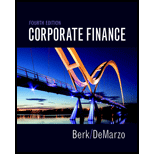
To determine: The equity cost of capital of Company P’s stock.
Introduction:
Cost of capital refers to the return that the investors expect on a particular investment. In other words, it refers to the compensation demanded by the investors for using their capital.
Answer to Problem 1P
The equity cost of capital of Company P’s stock is 5.85 percent.
Explanation of Solution
Given information:
Company P’s stock has a beta of 0.57. The risk-free rate is 3 percent and the market portfolios expected return is 8 percent.
The formula to calculate the expected return using CAPM is as follows:
Note: The cost of capital is estimated by computing the expected return. The
Here
“E (Ri)” refers to the expected return on a risky asset.
“Rf” refers to the risk-free rate.
“E (RM)” refers to the expected return on the market portfolio.
“βi” refers to the beta coefficient of the risky asset relative to the market portfolio.
Calculate the expected return or cost of the capital as follows:
Hence, the cost of capital is 5.85%.
Want to see more full solutions like this?
Chapter 12 Solutions
Corporate Finance Plus MyLab Finance with Pearson eText -- Access Card Package (4th Edition) (Berk, DeMarzo & Harford, The Corporate Finance Series)
- Don't use chatgpt!! 1. What does the term “liquidity” refer to in finance?A) Profitability of a companyB) The ease of converting assets into cashC) The amount of debt a firm hasD) The tax rate on investmentsarrow_forward3. A higher beta in the Capital Asset Pricing Model (CAPM) indicates:A. Lower volatility compared to the marketB. Higher volatility compared to the marketC. Guaranteed returnsD. Lower expected returnarrow_forwardDon't use chatgpt!! Diversification helps reduce:A. Systematic riskB. All financial risksC. Unsystematic riskD. Liquidity riskarrow_forward
- Don't use chatgpt!! The net present value (NPV) of a project is:A. The total profit of the projectB. The sum of all cash flowsC. The difference between present value of inflows and outflowsD. Equal to internal rate of returnarrow_forwardIf net income is $25,000 and total equity is $125,000, what is the return on equity (ROE)?A. 10%B. 15%C. 20%D. 25%arrow_forwardDon't use chatgpt! help in this question. Which of these is not a money market instrument?A. Treasury billB. Certificate of depositC. Commercial paperD. Corporate bondarrow_forward
- I need help ! no ai Which of these is not a money market instrument?A. Treasury billB. Certificate of depositC. Commercial paperD. Corporate bondarrow_forwardNo chatgpt! Which of these is not a money market instrument?A. Treasury billB. Certificate of depositC. Commercial paperD. Corporate bondarrow_forwardDont use Chatgpt! Which of these is not a money market instrument?A. Treasury billB. Certificate of depositC. Commercial paperD. Corporate bondarrow_forward
- I need help step by step with correct values.arrow_forwardNo AI What does the price-to-earnings (P/E) ratio measure?A. Company’s dividend yieldB. Value of assets per shareC. Market price relative to earnings per shareD. Return on equityarrow_forwarddon't use AI Which of the following is a primary market activity?A. Buying shares from another investorB. Selling bonds on a stock exchangeC. A company issuing new stock to the publicD. Trading derivatives on a futures exchangearrow_forward
 Essentials Of InvestmentsFinanceISBN:9781260013924Author:Bodie, Zvi, Kane, Alex, MARCUS, Alan J.Publisher:Mcgraw-hill Education,
Essentials Of InvestmentsFinanceISBN:9781260013924Author:Bodie, Zvi, Kane, Alex, MARCUS, Alan J.Publisher:Mcgraw-hill Education,

 Foundations Of FinanceFinanceISBN:9780134897264Author:KEOWN, Arthur J., Martin, John D., PETTY, J. WilliamPublisher:Pearson,
Foundations Of FinanceFinanceISBN:9780134897264Author:KEOWN, Arthur J., Martin, John D., PETTY, J. WilliamPublisher:Pearson, Fundamentals of Financial Management (MindTap Cou...FinanceISBN:9781337395250Author:Eugene F. Brigham, Joel F. HoustonPublisher:Cengage Learning
Fundamentals of Financial Management (MindTap Cou...FinanceISBN:9781337395250Author:Eugene F. Brigham, Joel F. HoustonPublisher:Cengage Learning Corporate Finance (The Mcgraw-hill/Irwin Series i...FinanceISBN:9780077861759Author:Stephen A. Ross Franco Modigliani Professor of Financial Economics Professor, Randolph W Westerfield Robert R. Dockson Deans Chair in Bus. Admin., Jeffrey Jaffe, Bradford D Jordan ProfessorPublisher:McGraw-Hill Education
Corporate Finance (The Mcgraw-hill/Irwin Series i...FinanceISBN:9780077861759Author:Stephen A. Ross Franco Modigliani Professor of Financial Economics Professor, Randolph W Westerfield Robert R. Dockson Deans Chair in Bus. Admin., Jeffrey Jaffe, Bradford D Jordan ProfessorPublisher:McGraw-Hill Education





